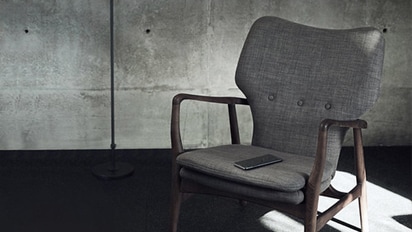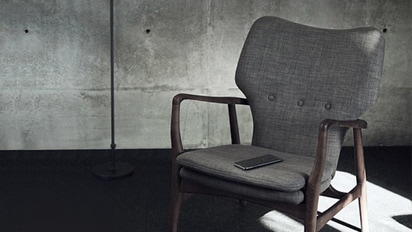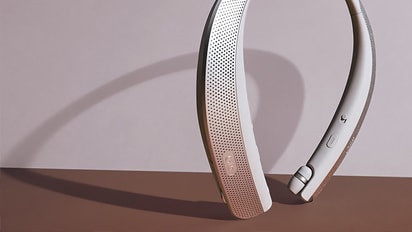At a Glance
Water overfilling the ice tray is usually the result of high water pressure in the home. However, depending on the type of ice maker that your refrigerator has, troubleshooting can be performed to help correct this issue.
[LG Refrigerators] Ice Tray Is Overfilling with Water
Today we're going to talk about your ice tray overfilling with water. Now, a lot of times you can determine that is because in your ice bucket, the top is just all blocked and clumped up or when you see the ice, you can see like four or six cubes all tied together still, they look like a little brick there.
What is slabbing? You can actually open the ice room, remove the bucket, and on some models, you can actually look down with the light and see that instead of the water level being to where you get all these individual ice cubes, the water levels up high enough that it's basically making a brick, what we call slabbing.
If you do get water that's overflowing your ice tray, it's usually caused by water pressure, either too high or too low. Now, depending on the refrigerator you have, it will tell you that the water pressure should be anywhere between 20 and 120 psi or if you have a filter like this one does, the water pressure needs to be between 40 and 120 psi.
Water pressure, now what happens is water pressure is actually electrically we open the water valve then when we remove the electricity we count on the water pressure to snap it shut for us. So if you have low water pressure, it doesn't snap the valve close and what will happen is it can actually drip and keep dripping and that's what causes this problem of overfilling the tray.
Now at a local hardware store, one of the big box stores, you can actually purchase for about 10-12 bucks, it's called a water pressure gauge. I've shown one in a previous video, unfortunately, I didn't bring it today, but this thing screws onto an outside faucet, you turn your water on and it tells you how much pressure is there at your home.
So if the water pressure is below what's required for your refrigerator, either 20 or 40, you need to find out why, you need to do something to increase your water pressure. It may be a call to the water company to see if something can be done or a call to your plumber to see if maybe it's a real old house that the pipes have started closing down on you, but whatever the case, we have to have the proper water pressure to the refrigerator so it doesn't drip through.
Now on the flip side of that, you could have too high of water pressure and if it's above 120 psi, sometimes during that certain period of time we're supposed to take water to get this thing properly filled, we're getting too much water in, so in that case and this just happened at my own house, my pressure regulator had gone bad and I started getting like 150 psi at my home and had to go out and replace my pressure regulator.
But overflowing ice tray is caused by too much water, which is caused by water pressure. So too much, that's usually an easy fix, a pressure regulator is added right where the water comes off your meter, they put a regulator in, it regulates the flow into your house, and it’s an easy fix.
Too little water pressure, that's something that gets a little more complicated, that could either be a water company, I've also had rural properties where the pump wasn't big enough so the well wasn't bringing it in, so they had to buy a bigger pump to increase the flow to the house.
So if you get an ice tray that's overflowing, you're seeing water frozen on top, four to six cubes all held together, you need to check your water pressure and that will tell you if you need to call a plumber or your water company. . Hopefully, this helped you with ice tray overfilling with water. On behalf of LG, have a great day.
Try This
-
Please select your type of ice maker:
-
Twist-N-Serve/Flex Tray
Show ScriptHow to Run an Ice Maker Test
If your ice maker was working but now is not making ice, there is a simple diagnostic test you can run that may provide some insight on what that problem is. To run the ice maker's test mode, pull the handle to open the ice room and remove the ice bucket.
Today, we'll show you how to run the test mode on two styles of ice makers.
On this first model, this is the power button. Make sure it is turned on. The test button is underneath here, below the ice tray. There's a light sensor that prevents the ice bucket from overfilling.
Place a towel on the ice room to catch any water or ice that may fall when you run the test mode. Press and hold the test button for about three seconds. The ice maker will begin to turn. If water or ice were to fall from the tray, the towel is there to catch it. The tray only holds about four or five ounces of water.
Here's a different style of ice maker. On this model, there is no power switch and no tray. Even though there's no tray, you should still place a towel below the ice maker before running the test mode.
On this unit, you will need a thin piece of metal like a paper clip to press the test mode button. Place it in the hole and press and hold the button for about three seconds until the arms start to turn.
One note about this model of ice maker, for the first two hours the refrigerator has been plugged in, the ice maker test can only be run once. If you wish to run the test mode a second time after a recent installation, unplug the unit for about 30 seconds to reset the ice maker.
If the refrigerator has been plugged in for more than two hours, test mode can be run multiple times.
Running this ice maker test mode will provide two key pieces of information: Did the motor run? Was there water or ice in the tray? This assumes that the water supply to the refrigerator is secure and in good shape. If the answer is no to either of these questions, the refrigerator most likely needs service.
Visit lg.com to find a local repair center near you.
NoteWater pressure should be anywhere between 20 and 120psi.
Cause:
If your Twist-N-Serve ice maker is overfilling with water, this can be caused by high water pressure
Resolution:
1Partially close the water valve connected to the refrigerator to reduce water pressure.
2Purchase a water pressure regulator to decrease the water pressure.
3Install the water pressure regulator (this can be purchased from a local hardware store).
4Test the ice maker.
How to test ice maker:
The test button is located at the front/bottom of the icemaker. Press and hold 3 to 5 seconds or until icemaker starts to move.
-
Heater/Custom Cube
Show ScriptHow to Run an Ice Maker Test
If your ice maker was working but now is not making ice, there is a simple diagnostic test you can run that may provide some insight on what that problem is. To run the ice maker's test mode, pull the handle to open the ice room and remove the ice bucket.
Today, we'll show you how to run the test mode on two styles of ice makers.
On this first model, this is the power button. Make sure it is turned on. The test button is underneath here, below the ice tray. There's a light sensor that prevents the ice bucket from overfilling.
Place a towel on the ice room to catch any water or ice that may fall when you run the test mode. Press and hold the test button for about three seconds. The ice maker will begin to turn. If water or ice were to fall from the tray, the towel is there to catch it. The tray only holds about four or five ounces of water.
Here's a different style of ice maker. On this model, there is no power switch and no tray. Even though there's no tray, you should still place a towel below the ice maker before running the test mode.
On this unit, you will need a thin piece of metal like a paper clip to press the test mode button. Place it in the hole and press and hold the button for about three seconds until the arms start to turn.
One note about this model of ice maker, for the first two hours the refrigerator has been plugged in, the ice maker test can only be run once. If you wish to run the test mode a second time after a recent installation, unplug the unit for about 30 seconds to reset the ice maker.
If the refrigerator has been plugged in for more than two hours, test mode can be run multiple times.
Running this ice maker test mode will provide two key pieces of information: Did the motor run? Was there water or ice in the tray? This assumes that the water supply to the refrigerator is secure and in good shape. If the answer is no to either of these questions, the refrigerator most likely needs service.
Visit lg.com to find a local repair center near you.
NoteWater pressure should be anywhere between 20 and 120psi.
Cause:
If your CustomCube™ ice maker is overfilling with water, this can be caused by high water pressure, or the result of the SIZE SELECTOR being set too high.
Resolution:
1Partially close the water valve connected to the refrigerator to reduce water pressure.
2Reduce the size of the ice using the size selector.
3Perform an ice maker test to see if the problem continues.
How to test ice maker:
Use a toothpick, paperclip, or similar object to press the cube size selector button for 3 to 5 seconds or until the icemaker starts to move.
-
Early Twist/Flex Tray
NoteWater pressure should be anywhere between 20 and 120psi.
Cause:
If your ice maker is overfilling with water, the flow sensor that determines how much water is flowing to the ice maker may be malfunctioning.
Resolution:
1Partially close the water valve connected to the refrigerator to reduce water pressure.
2Press and hold the [ICE PLUS] and [FREEZER TEMP] buttons at the same time.
3If "gF" appears in the display, the unit will require service.
How to test ice maker:
The test button is located on the right side of the icemaker. Press and hold the button for 3 to 5 seconds or until the icemaker starts to move.
-
Craft Ice Maker
NoteWater pressure should be anywhere between 20 and 120psi.
Cause:
If your craft ice maker is overfilling with water, this can be caused by high water pressure, or warm air entering the ice maker creating condensation.
Resolution:
1Partially close the water valve connected to the refrigerator to reduce water pressure.
2Lower the freezer temperature.
NoteThe recommended freezer temp is 0°F or below.
3Check the door gasket to ensure the freezer is sealed properly.
How to test ice maker:
The test button is located at the front/bottom of the ice maker. Press and hold the button for 3 to 5 seconds or until the icemaker starts to move.
If the problem persists, service will be required please visit our Request a Repair page for further assistance.












